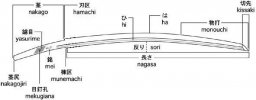- Joined
- Jan 21, 2019
- Messages
- 43
I have another small "Tanto"? I don't know much about it, I bought it for $120 and included another full size Katana. The full size katana was said to be WW2, however, the only marking on the blade beneath the handle is a small ships anchor symbol. I wasn't able to find anything out about that one. But the small one is what is interesting to me. I'm not sure if its original or not. Below are some pictures that I took. Any info that anyone can provide for me is greatly appreciated.
Small sword
There is some writing on another sword I bought at a garage sale. I think its chinese writing, if anyone knows anything about this, its greatly appreciated.
sword 2
Kruser
Small sword
There is some writing on another sword I bought at a garage sale. I think its chinese writing, if anyone knows anything about this, its greatly appreciated.
sword 2
Kruser




